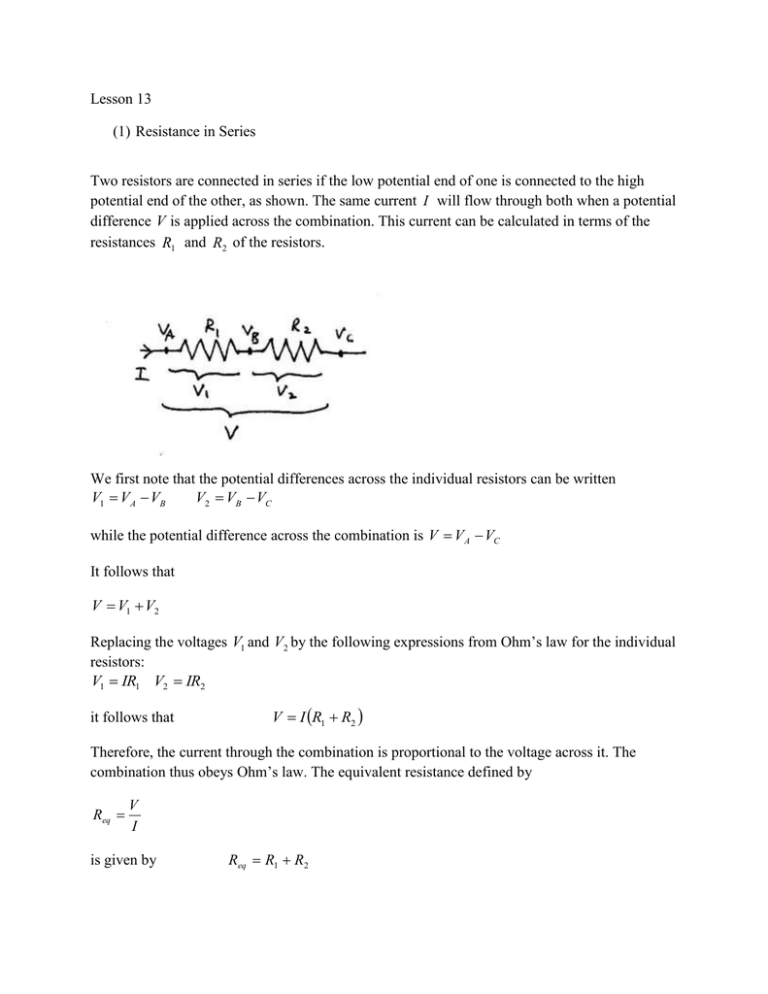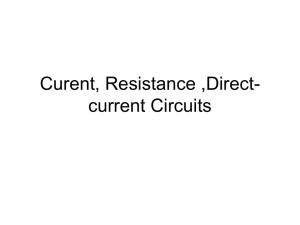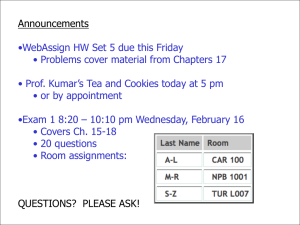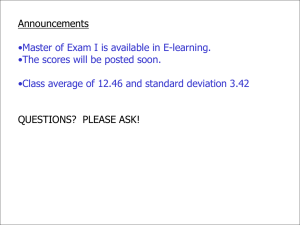The current through the resistor is
advertisement

Lesson 13 (1) Resistance in Series Two resistors are connected in series if the low potential end of one is connected to the high potential end of the other, as shown. The same current I will flow through both when a potential difference V is applied across the combination. This current can be calculated in terms of the resistances R1 and R2 of the resistors. We first note that the potential differences across the individual resistors can be written V1 V A VB V2 VB VC while the potential difference across the combination is V V A VC It follows that V V1 V2 Replacing the voltages V1 and V2 by the following expressions from Ohm’s law for the individual resistors: V1 IR1 V2 IR2 it follows that V I R1 R2 Therefore, the current through the combination is proportional to the voltage across it. The combination thus obeys Ohm’s law. The equivalent resistance defined by Req V I is given by Req R1 R2 Multiplying both sides of the equation V V1 V2 by I , we see that the power delivered to the combination is equal to the sum of the powers dissipated in each resistors: P P1 P2 When two or more resistors are in series, the equivalent resistance is Req R1 R2 and is always greater than each individual resistance. Example: The resistances of three resistors in series are 2 , 3 and 4 . Find the equivalent resistance and the current through each resistor. Find also the voltage across each resistor and the power dissipated in each when a voltage of 5V is applied across the combination. Solution: The equivalent resistance is Req R1 R2 R3 2 3 4 9 The current through each is the same, and is given by I V 5 0.56 A Req 9 The voltages are V1 IR1 0.56 2 1.12V V2 IR2 0.56 3 1.68V V3 IR3 0.56 4 2.24V The powers dissipated are P1 I 2 R1 0.56 2 2 0.63W P2 I 2 R2 0.56 2 3 0.94W P3 I 2 R3 0.56 2 4 1.25W Note that the voltage across the largest resistance is the largest, as is also the dissipated power. If we calculate the power delivered to the combination from P IV 0.56 5 2.80W and compare it with the total from P1 P2 P3 0.63 0.94 1.25 2.82W we see that they differ only because of inaccuracy in arithmetics. (2) Resistors in Parallel Two resistors are said to be in parallel when their high potential ends are connected as are also their lower potential ends. Current would enter the high potential end and exit the low potential end. In this case, both resistors share the same potential difference, but the currents are in general different. If the currents are I 1 and I 2 , then the total current entering and exiting the combination is I I1 I 2 because as much current must enter a junction as leaving it so that charge does not accumulate, a requirement of steady flow. Replacing I 1 and I 2 by the expressions I1 V R1 I2 V R2 which represent Ohm’s law for the two resistors, we find 1 1 I V R1 R2 This shows that the combination also obeys Ohm’s law, with an equivalent resistance Req satisfying the equation 1 1 1 Req R1 R2 Multiplying both sides of the equation I I1 I 2 by V leads to the equality P P1 P2 showing that the power delivered to the combination is equal to the sum of powers delivered to the individual resistors For an arbitrary number of resistors in parallel, the equivalent resistance satisfies 1 1 1 Req R1 R2 and Req is less than any of the resistance of the individual resistors. Example: The resistances of three resistors in parallel are 2 , 3 and 4 . Find the equivalent resistance. Find the current flowing into the combination, the current through each resistor, and the power dissipated in each when a voltage of 5V is applied across the combination. Solution: For the equivalent resistance, Req 1 1 1 1 0.50 0.33 0.25 1.08 Req 2 3 4 1 0.93 1.08 The current flowing into the combination is V 5 I 5.38 A Req 0.93 Since the potential difference across each resistor is 5V , the currents are given as follows: through the 2 I1 V 5 2.5 A R1 2 through the 3 I2 V 5 1.67 A R2 3 through the 4 I3 V 5 1.25 A R3 4 The powers are given by P1 V 2 52 12.5W R1 2 P2 V 2 52 8.33W R2 3 P3 V 2 52 6.25W R3 4 Note that the smaller the resistance, the larger the current it carries: Current seeks the path of least resistance. We also have P1 P2 P3 27.1W to be compared with P IV 5.38 5 26.9W The slight difference arises from inaccuracy in arithmetic’s. (3) Resistors in Series and Parallel Example: Find the equivalent resistance and the current through each resistor in the circuit below., given that R1 1, R2 2, R3 3,V 5V Solution: First find the equivalent resistance R12 that replaces R1 and R2 . This is given by 1 1 1 1 0.5 1.5 R12 1 2 R12 Now we have the equivalent circuit: 1 0.67 1.5 The equivalent resistance is Req R12 R3 0.67 3 3.67 The current into the combination is I V 5 1.36 A Req 3.67 The voltage across the equivalent resistance R12 is V12 IR12 1.36 0.67 0.91V The voltages across the resistors R1 and R2 are V1 V2 V12 0.91V The voltage across the resistor R3 is V3 IR3 1.36 3 4.08V V1 0.91 0.91A R1 1 V 0.91 The current through the resistor R2 is I 2 2 0.46 A R2 2 The current through the resistor R3 is I 3 I 1.36 A The powers are P1 I 12 R1 0.912 1 0.83W P2 I 22 R2 0.46 2 2 0.42W The current through the resistor R1 is I1 P3 I 32 R3 1.36 2 3 5.55W As a check, the sum of the powers is P1 P2 P3 0.83 0.42 5.55 6.8W which is to be compared with P IV 1.36 5 6.8W (4) Electromotive Force (EMF) We first introduce the idea of increment of electric potential for a resistor in a circuit. We identity the terminals 𝑎 and 𝑏 of a resistor 𝑅 and imagine traversing it from 𝑎 to 𝑏. We define the increment of potential from a to b as Δ𝑉 = 𝑉𝑏 − 𝑉𝑎 . We also draw an arrow to indicate the flow of current 𝐼. If the arrow is from 𝑎 to b , Ohm’s law can be written in the form Δ𝑉 = −𝐼𝑅 On the other hand, if the arrow is from 𝑏 to 𝑎, Ohm’s law takes the for Δ𝑉 = 𝐼𝑅 Note that in these formulas, 𝐼 can be positive or negative. In a circuit loop, the net change in electric potential is zero, because each point of the circuit has a definite potential, and we are returning to the same point. This can be expressed as: ∑ Δ𝑉 = 0 Since according to Ohm’s law, electrical current can only flow from a point of high potential to one of low potential, it cannot flow in the circuit if only resistors are present in the circuit. A device at some location in the circuit is needed to raise the potential in order to maintain a current, just as a pump is required to keep water from flowing in a loop that goes up and down. A battery is an example of such a device. The symbol of such a device is as shown, consisting a positive terminal and a negative terminal, where the electric potentials are denoted by 𝑉+ and 𝑉− respectively. When a quantity of charge Δ𝑞 goes from the negative to the positive terminal within the device, there is an increase of electric potential energy Δ𝑞(𝑉+ − 𝑉− ) = Δ𝑞Δ𝑉 This is due to the work done by forces within the device, and this work is expected to be proportional to Δ𝑞. By definition, the emf ℰ of the device is the work done per unit charge. It can also be considered as the energy generated by the device when a unit of charge goes through it. Thus the work done or energy generation by the device is Δ𝑞ℇ If this energy is not lost, as in an ideal battery, we must have Δ𝑉 = ℇ Therefore the emf of the device can raise the potential going from the negative to the positive terminal. We also see that the unit of emf is the Volt. When a current 𝐼flows through the battery, it generates the power 𝑃 = 𝐼ℇ The rate of increase of electrical potential energy is 𝐼Δ𝑉 If the device is not ideal, some of the power generated is lost inside the device. This loss can be described as an internal resistance 𝑟 so that the rate of loss is 𝐼2𝑟 Energy conservation then gives 𝐼ℇ = 𝐼Δ𝑉 − 𝐼 2 𝑟 From which it follows that Δ𝑉 = ℇ − 𝐼𝑟 This formula can be considered as the increment of electric potential in traversing the battery from the negative to the positive terminal, when the arrow of current flow is drawn from the negative to the positive terminal: (5) Single Loop Circuit A single loop circuit is formed by connecting the terminals of a battery to those of a resistor, which is called the load. To find the current in the loop, we first draw an arrow in the loop to represent the current flow. Next we imagine traversing the loop in the same direction as indicated by the arrow, and write down the increment of electric potential as we goes through each element of the circuit, of which there are two: the battery and the load resistor. Then we write down the loop equation ∑ Δ𝑉 = 0 The result is (ℇ − 𝐼𝑟) + (−𝐼𝑅) = 0 From which the current can be found: 𝐼= ℇ 𝑅+𝑟 The absolute value of the potential difference across the terminals of the battery is called the terminal voltage. It is the same as the voltage across the load resistor, and is equal to 𝑉 = 𝐼𝑅 = ℇ − 𝐼𝑟 It is therefore less than the emf if the battery is not ideal. The power delivered to the load is 𝑃 = 𝐼2𝑅 = ℇ2 𝑅 (𝑅 + 𝑟)2 Very little power is delivered to the load if its resistance is very low or very high. To find the maximum, we set the derivative of 𝑃 with respect to 𝑅 to zero: 𝑑𝑃 1 2𝑅 𝑟−𝑅 = ℇ2 [ − ] = ℇ2 =0 2 3 (𝑅 + 𝑟) (𝑅 + 𝑟) (𝑅 + 𝑟)3 𝑑𝑅 Thus the maximum occurs when the load resistance is equal to the internal resistance.








